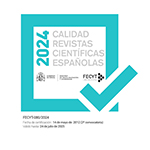Detección de barrios vulnerables a partir de la accesibilidad a los servicios públicos de proximidad. El caso de la ciudad de Valencia
Resumen
El análisis de la accesibilidad a los servicios públicos de proximidad es una manera de acercarnos al estudio de la sostenibilidad social en las ciudades. En este artículo se analizacómo la localización de dichos servicios (centros de especialidades médicas, institutos de enseñanza secundaria y servicios sociales de base) contribuye a mejorar la calidad de vida de las personas. Para ello se ha estimado la accesibilidad desde el lugar de residencia al centro de oferta de servicio en la ciudad de Valencia utilizando SIG e información espacialmente detallada (por número de policía o portal). La relación entre dicha accesibilidad y una serie de variables de tipo socioeconómico facilita la detección de barrios con peores dotaciones sociales y permite caracterizar dichas áreas según su estructura socioeconómica y población en riesgo de exclusión, con el fin de facilitar la toma de decisiones para la intervención pública.Descargas
Descarga artículo
Licencia
La revista Anales de Geografía de la Universidad Complutense, para fomentar el intercambio global del conocimiento, facilita el acceso sin restricciones a sus contenidos desde el momento de su publicación en la presente edición electrónica, y por eso es una revista de acceso abierto. Los originales publicados en esta revista son propiedad de la Universidad Complutense de Madrid y es obligatorio citar su procedencia en cualquier reproducción total o parcial. Todos los contenidos se distribuyen bajo una licencia de uso y distribución Creative Commons Reconocimiento 4.0 (CC BY 4.0). Esta circunstancia ha de hacerse constar expresamente de esta forma cuando sea necesario. Puede consultar la versión informativa y el texto legal de la licencia.












